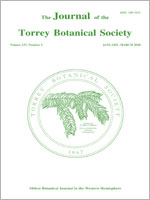Invasive plant species are often more successful within introduced areas when compared to their natural ranges. Allelopathy has been suggested as a potential mechanism for this success because invasive plants frequently establish monocultures and may produce allelochemicals evolutionarily novel to the recipient community. However, species are typically tested in isolation making the relative strength of allelopathy difficult to assess. We conducted laboratory bioassays for 10 co-occurring non-native species to determine the relative strength of their allelopathic potential. These species represented a suite of successful invaders within a young forest and were from a variety of plant life forms: trees, lianas, shrubs, and herbs. We determined the germination responses of a target species to a gradient of leaf extract concentrations to assess relative allelopathic potential. The relative strength of germination inhibition was quantified by the slope (β) of the germination response to plant extract concentration. Ailanthus altissima extract had the greatest inhibitory effect on target species germination out of all 10 species (β = −0.55) while the other tree species, Acer platanoides extract, had small effects on germination (β = −0.14). For lianas, Celastrus orbiculatus extract inhibited the target species (β = −0.28) more than Lonicera japonica extract (β = −0.06). All invasive shrub extracts had very small effects on seed germination (β value −0.03 to −0.19). Extracts of the two herbaceous species, Alliaria petiolata and Microstegium vimineum, had very large inhibitory effects (β = −0.37 and −0.38, respectively). In this system, we screened a suite of invasive species for allelopathic potential and determined the relative strength of germination inhibition. Most species, particularly invasive shrubs, did not exhibit sufficient allelopathic potential to suggest allelopathy would occur in the field. Four species, Ailanthus altissima, Alliaria petiolata, C. orbiculatus, and M. vimineum all exhibited strong germination inhibition and warrant additional study in the field.
How to translate text using browser tools
1 January 2010
Relative allelopathic potential of invasive plant species in a young disturbed woodland
Nikki L. Pisula,
Scott J. Meiners
allelopathy
bioassay
comparative ecology
germination inhibition
invasive species





